Project Series
Summerhouse, Pool and Garden Spa
Written by Jonathan Lees RIBA.
By now, you may have browsed through the writings regarding the design of the main house; if you haven’t had the opportunity of doing this, you can read my writing ‘Arts and Crafts Country House in Oxfordshire – A Project Memoir’, in the Writings Library, in order to give the context of how the Summerhouse was designed.
‘…… a summerhouse, including a spa pool, sauna and steam room that links to an external swimming pool.’
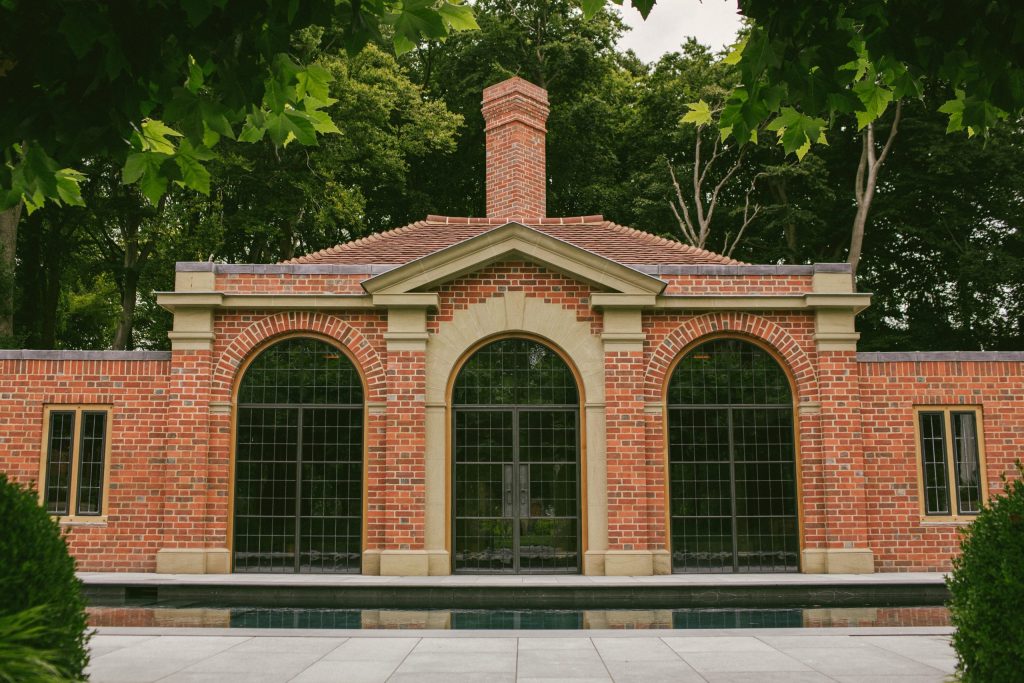
The Front Elevation of the Summerhouse facing the Pool
The concept for the Summerhouse and surrounding gardens were developed after the initial designs for the extension of the main house were developed. We were approximately twelve months into the process of construction and remodelling of the main house, when the client approached me to discuss the possibility of designing a summerhouse,including a spa pool, sauna and steam room that links to an external swimming pool. This was to be included as part of an overall landscaping package that we developed with Hendy Curzon.
‘…… clearly different in character to the largely vernacular, Arts and Crafts approach….’
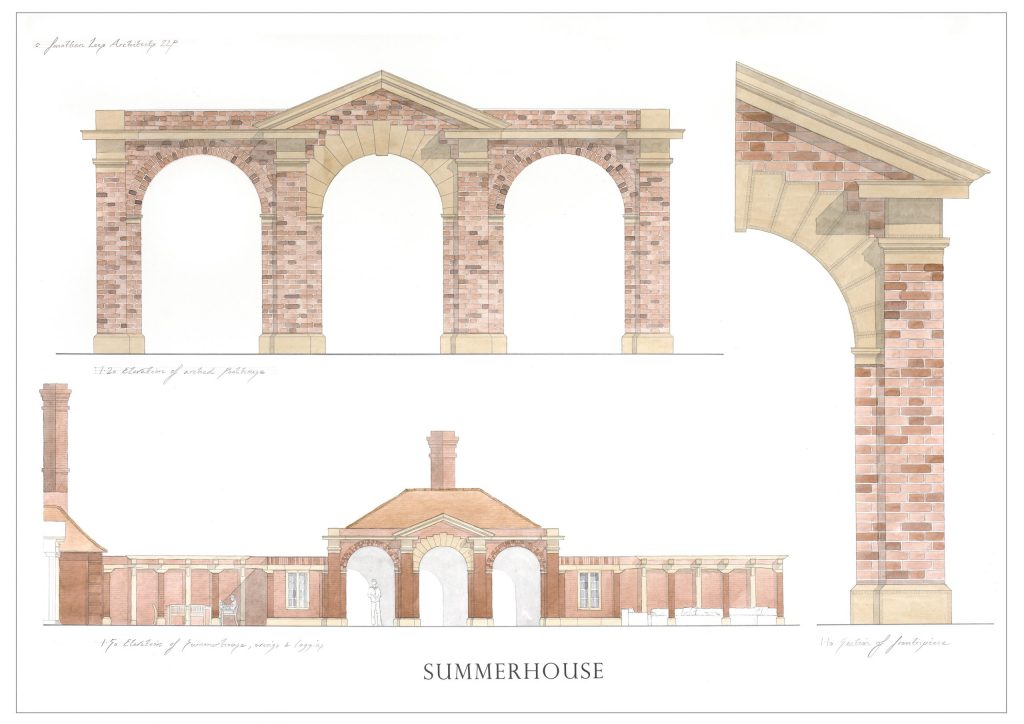
Watercolour sketch design for the Summerhouse
My initial thoughts on the design of the Summerhouse were to create something that resembled, or paid testament to ancient Roman baths. I aimed to develop the classical language of architecture, that was slowly but surely creeping into the design of the main house and was clearly different in character to the largely vernacular, Arts & Crafts approachpresent on the South elevation of the main house. We had already included details to the existing elevation that knittedclassical detailing with the vernacular, including the ornate stone door surrounds to the sitting room and kitchen, together with the classical frontis and surrounding symmetrical character of the orangery.
‘….. the site was perfect for the location of a sunroom and place to enjoy the gardens.‘
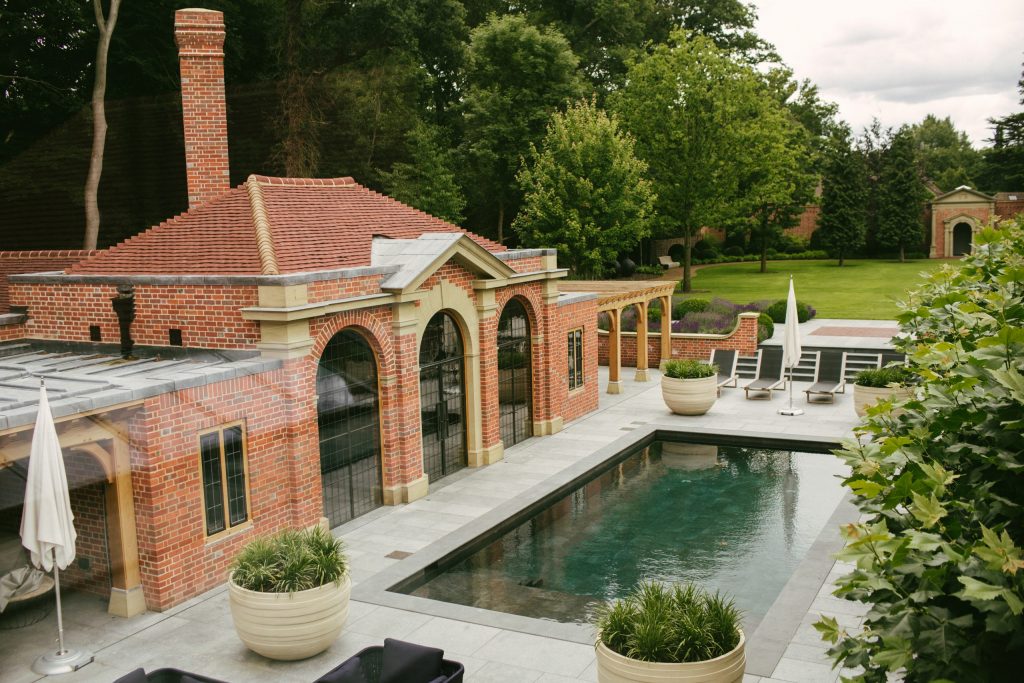
The Pool House and swimming pool facing the gardens
The brief for the Summerhouse design was to include an external space, both covered and uncovered, to enjoy during the summer. The area proposed off of the South elevation and to the Eastern side of the site was perfect for the location of a sunroom and place to enjoy the gardens. The swimming pool was a simple design that was sited on the central access line of the frontis to the orangery, in an area of paved limestone slabs. We used the same Irish Blue Kilkenny Limestone that we had used on the inside of the house, but this time with a flame-textured finish providing a stippled texture and lighter grey colour linking it to the inside space.
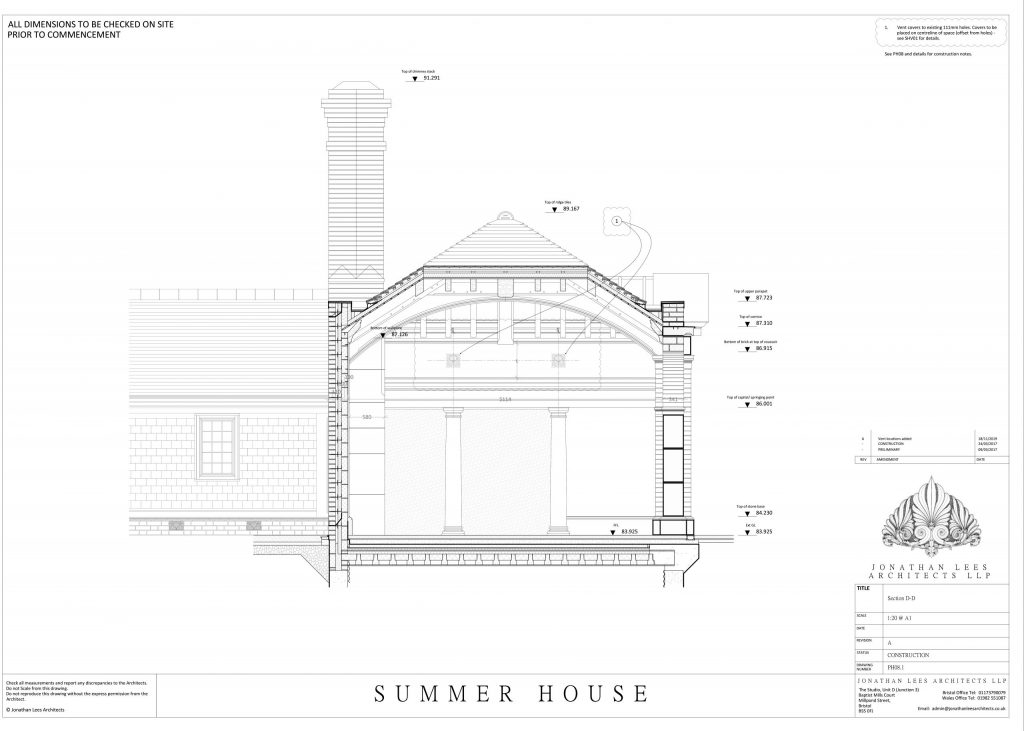
A CAD section through the Pool House
‘The summerhouse itself is a small structure that we packed full of detail.’
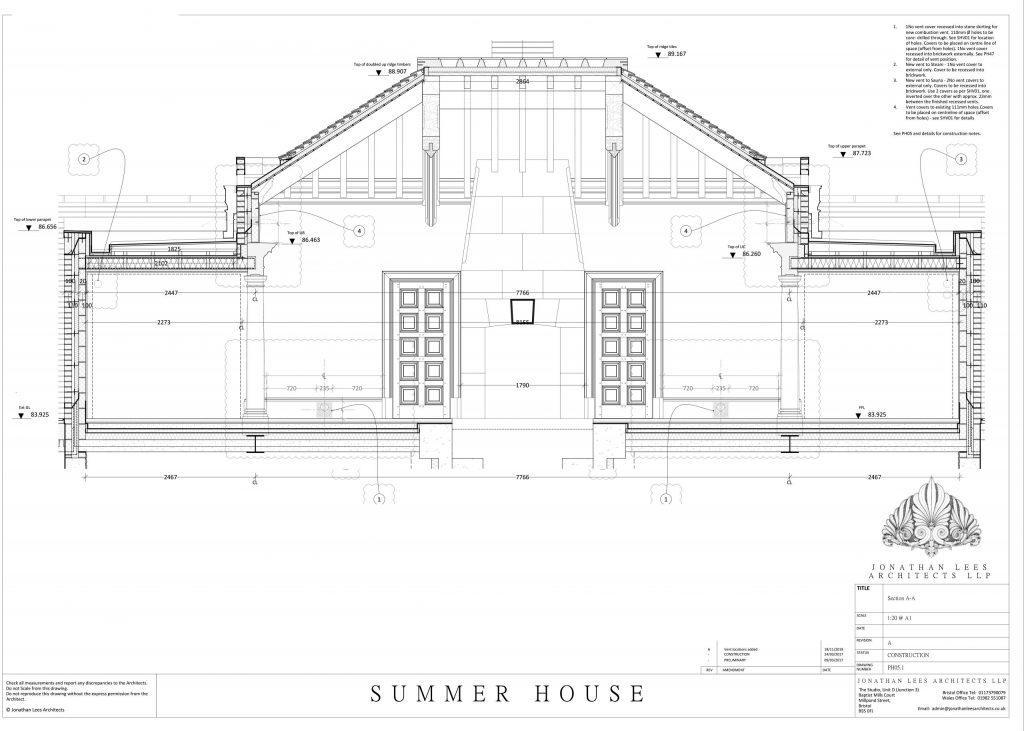
A CAD section through the pool house, sauna and steam room
The main Summerhouse elevation is sited on the East-West access to the centre of the swimming pool, with a termination of this access being the central bay of the Summerhouse and the apsed arch of the feature water fountain to the West side of the main lawn. The Summerhouse itself is a small structure that we packed full of detail. The exterior consists of simple brickwork side walls with tall walls forming the backs of two loggias which, in turn flank the Summerhouse on the North and South sides and link to the East wing of the main house. The texture of the handmade oak-fired bricks meant that we were able to create large expanses of wall without adorning them with overt detail and without the risk of them appearing austere.
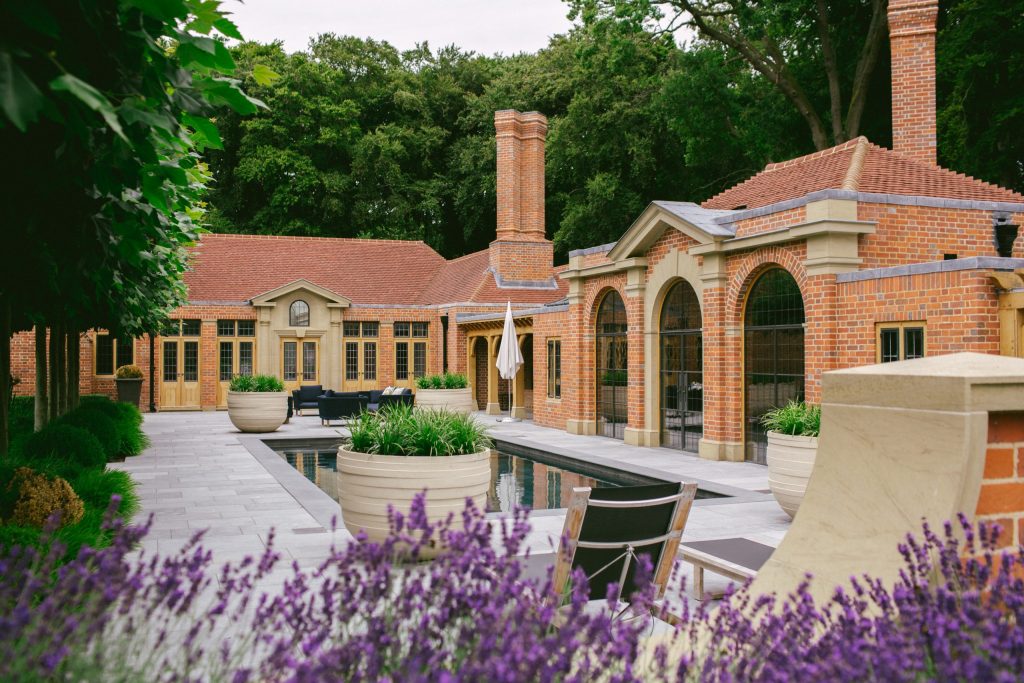
The pool and Summerhouse in relation to the Orangery
‘The tripartite of arches punch through the line of the entablature…...’
The main elevation of the Summerhouse faces West and consists of three large half-round arches, with the central bay pronounced over a pair of projecting piers. These are constructed in brickwork with stone bases and stone capitals. The tripartite of arches punch through the line of the entablature, creating a broken pediment over the main arch. Thisconsists of stone voussoirs, with our tooled margin and scabbled field, over which the tympanum is formed of brickwork with a raked stone pediment over. Each pier that forms the openings is framed by a stone pilaster capital, with an entablature over, and consists of a squared architrave and reduced cornice formed using only the corona of the moulding. Over this, a stone and brick capping course is capped with a leadwork parapet detail that travels around the Summerhouse and over each loggia and links back to the parapet of the main house, concealing the orangery roof. The parapet conceals a hidden box gutter that frames a simple hipped roof.
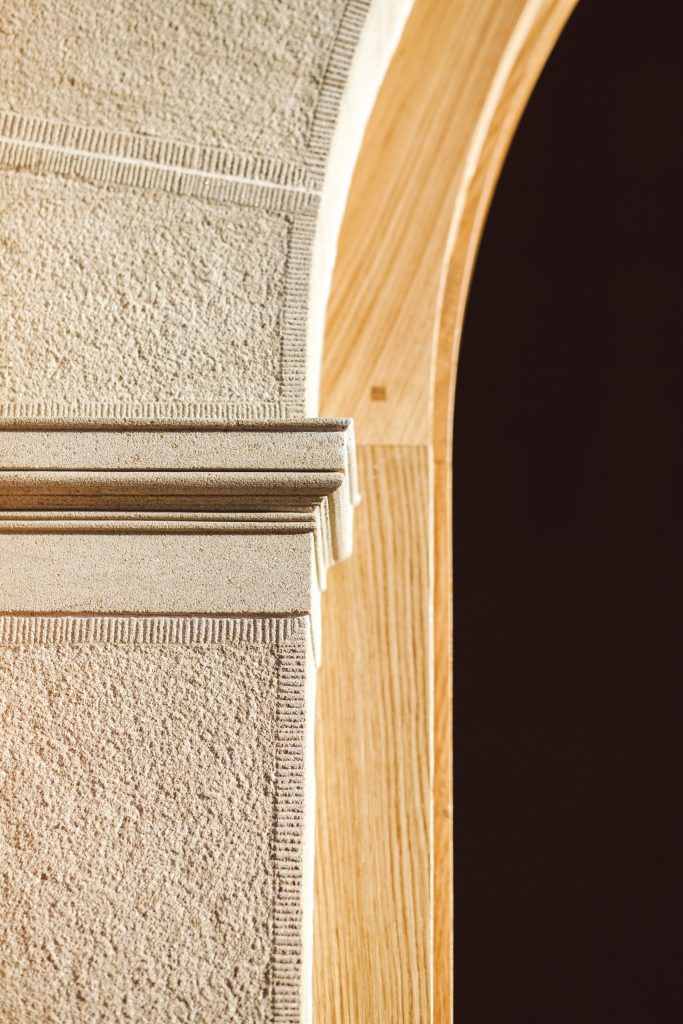
Detail of Oak frame and scabbled stone voussoirs
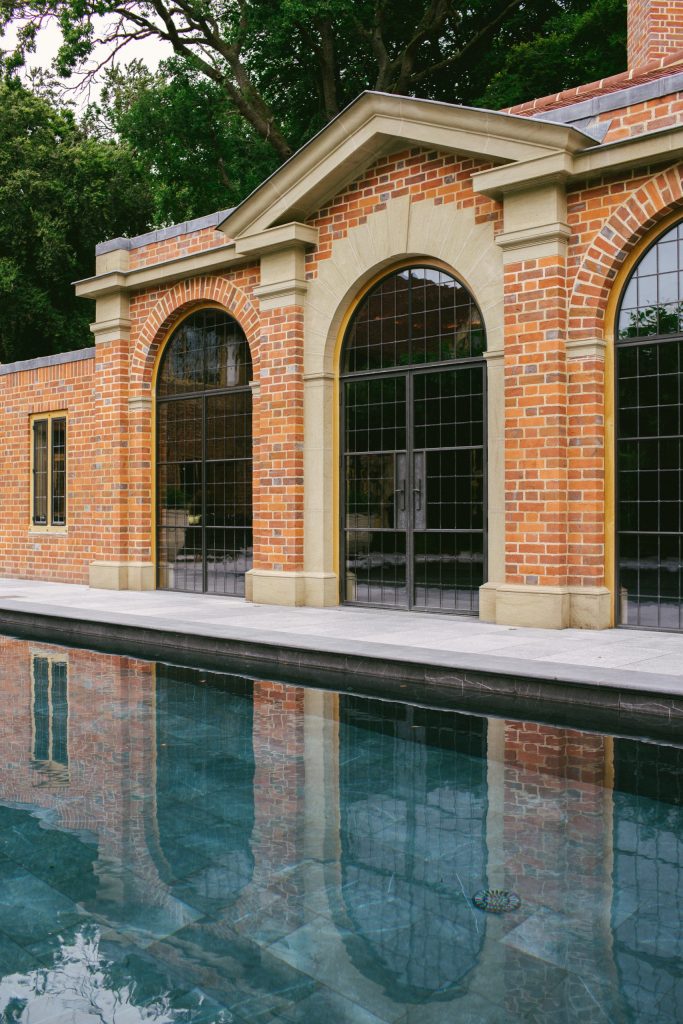
Classically inspired entrance
The rear elevation carries a large feature diamond shaped chimneystack with brick tumblers to the base.
The central arched opening to the front facade is flanked either side by matching sized arches created with double-header bricks with oak frames and bronze casement insets. These delicate leaded lights allow sunlight to flood into the central space. The flame-textured Kilkenny flooring passes from the pool area into the pool house without a level change. Drains surrounding the area are in the form of inch wide slots with set-in brass cover plates that we designed.
‘Internally, the space is dominated by two principal features. The first is an elaborate engineered Oak roof…...’
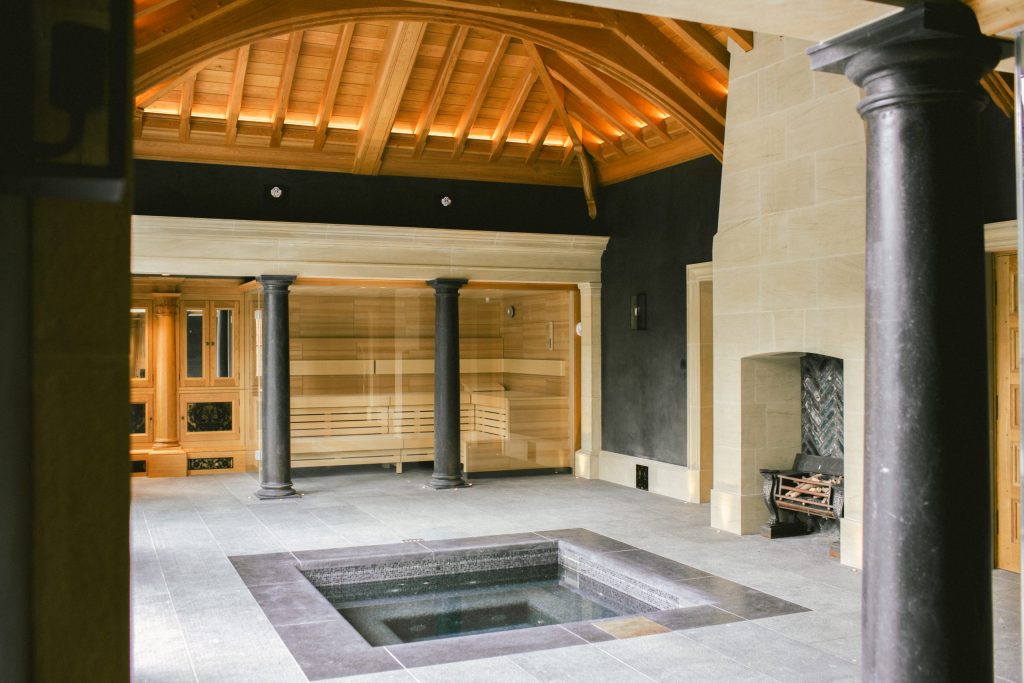
Internal view of the Summerhouse with Spa pool and Sauna
The ceiling also features corner corbel brackets that sit at the hips of the roof and support the principal hip rafters as they pass up to their connection detail with the crown post of the trusses. The ensemble was skilfully made and installed by Gelder Joinery.
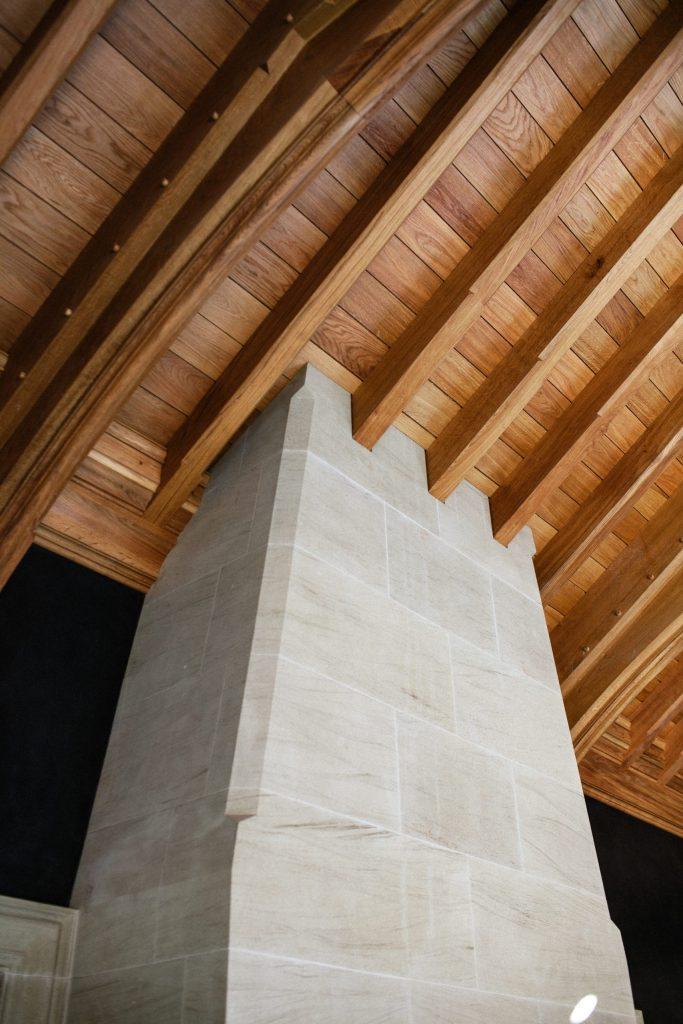
Central fireplace meeting Oak ceiling
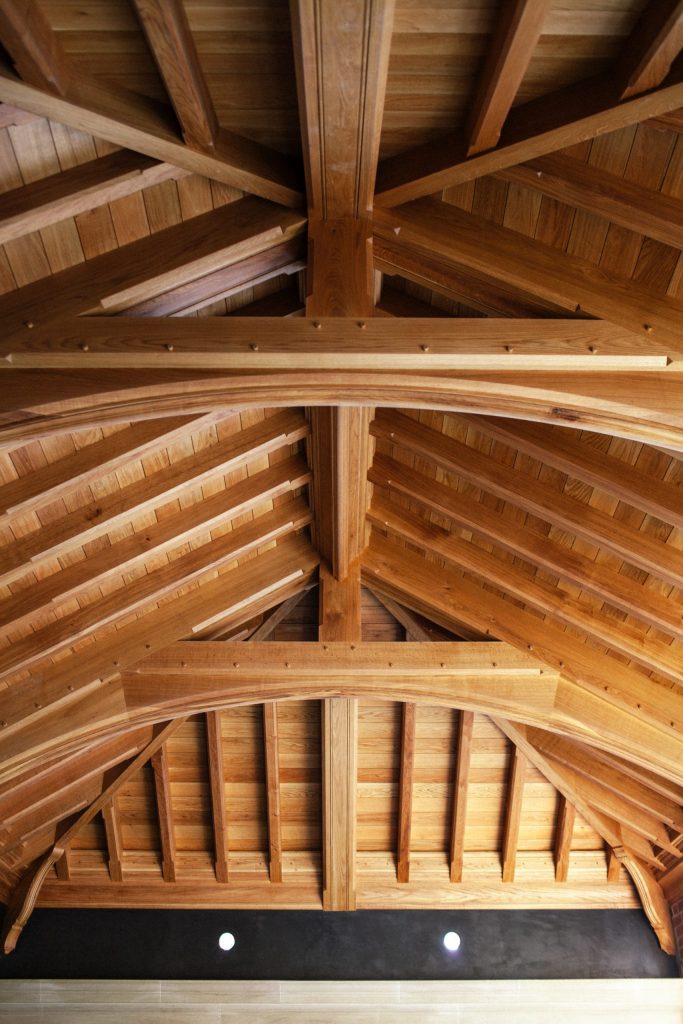
Bladed trusses in the Oak feature roof
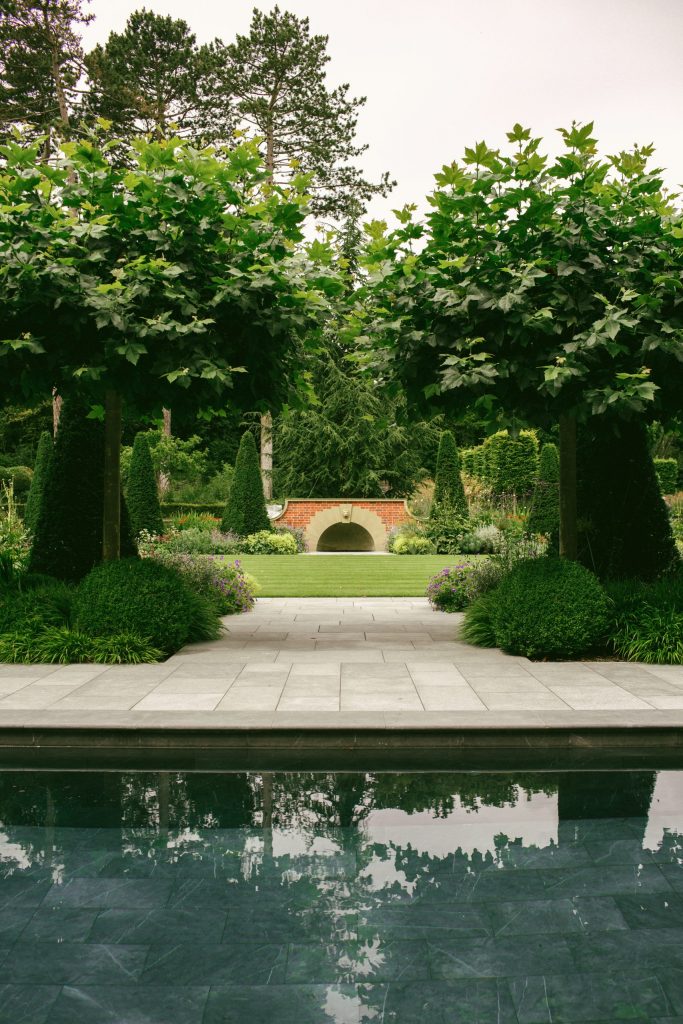
The view from the summerhouse
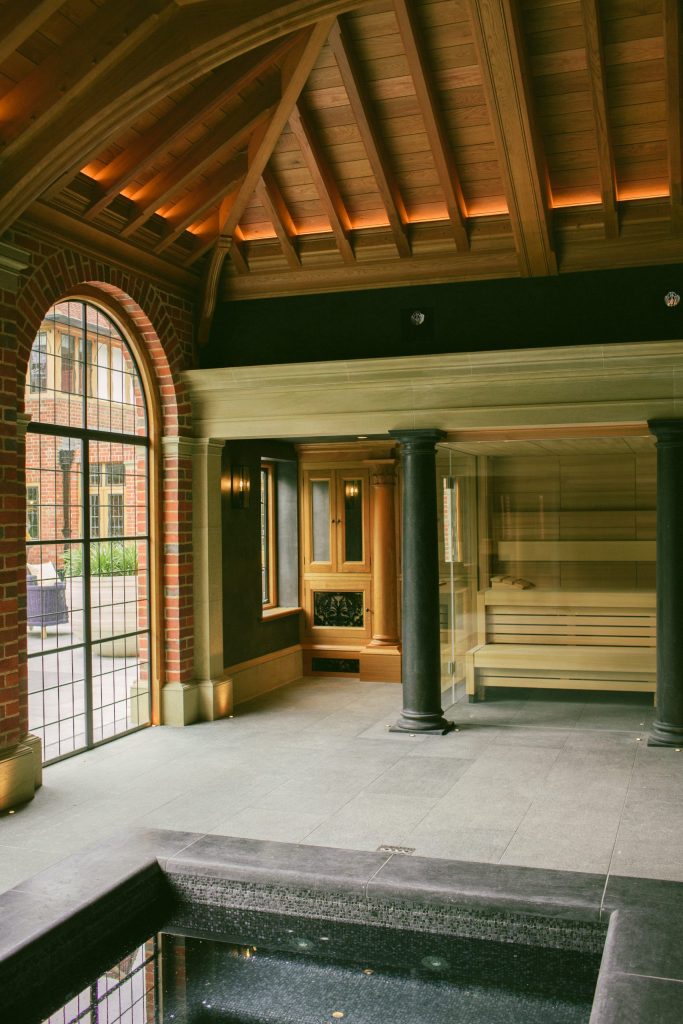
Spa pool, sauna and monolith black stone columns
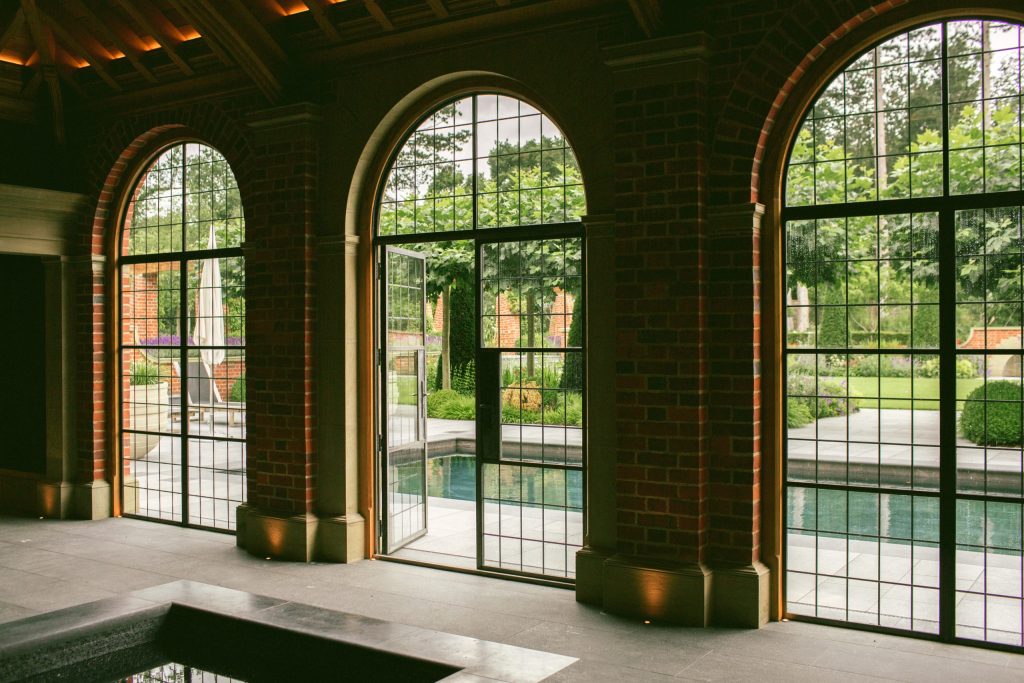
Triple arched openings with Crittal doors opening onto the pool terrace
The wings of the Summerhouse are single-storey with flat leaded roofs with a single oak-framed bronze casement window either side, allowing light to enter the wings. Internally, these wings are expressed by creating a massive stone entablature that spans from the North to the South elevations and supports the wall over the top, forming the main mass of the summerhouse. Underneath this large full entablature consisting of an architrave, frieze and cornice, are a pair of Irish Blue Kilkenny Doric columns, carved from monoliths, meaning that the entire column was turned from one piece of stone. Rather than polishing the columns, we decided to have a honed finish to create a soft texture to the face and which compliments the same flame-textured stone of the floor. Behind each pair of columns are the glass enclosures of the steam room and sauna set back in floor channels, allowing the glass panels to jump from floor to ceiling without a barrier. The glass is set back only a couple of inches away from the back of the columns, which reflect in the glass, providing extra depth to the space.
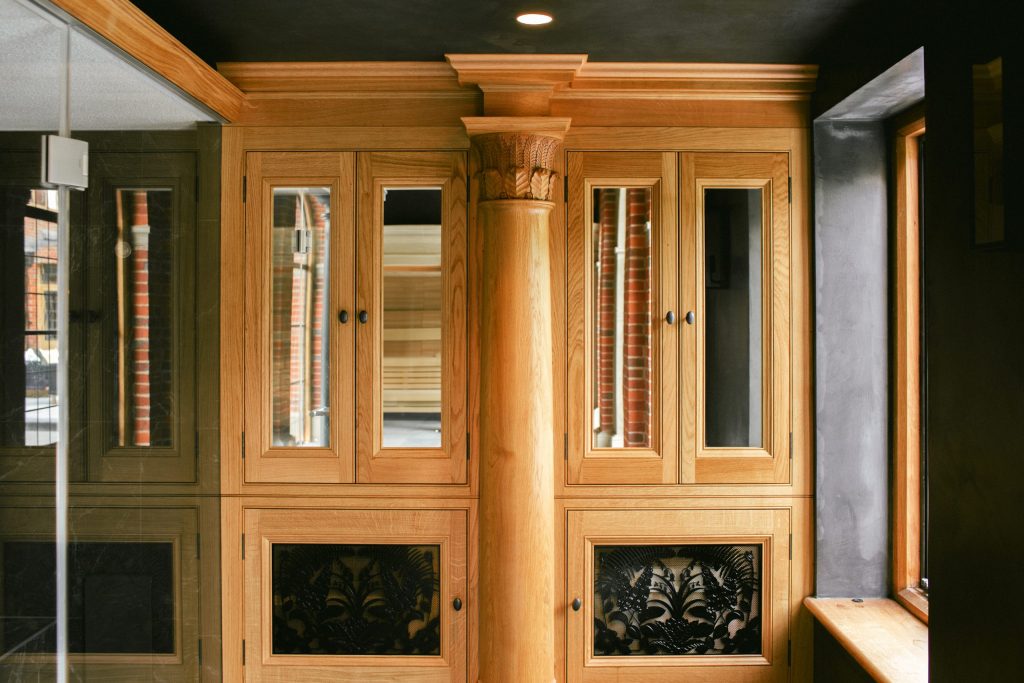
Mirrored Oak cabinets concealing pool equipment
‘…unfluted Corinthian columns developed in our own style using the beech and fern leaf motif…..’
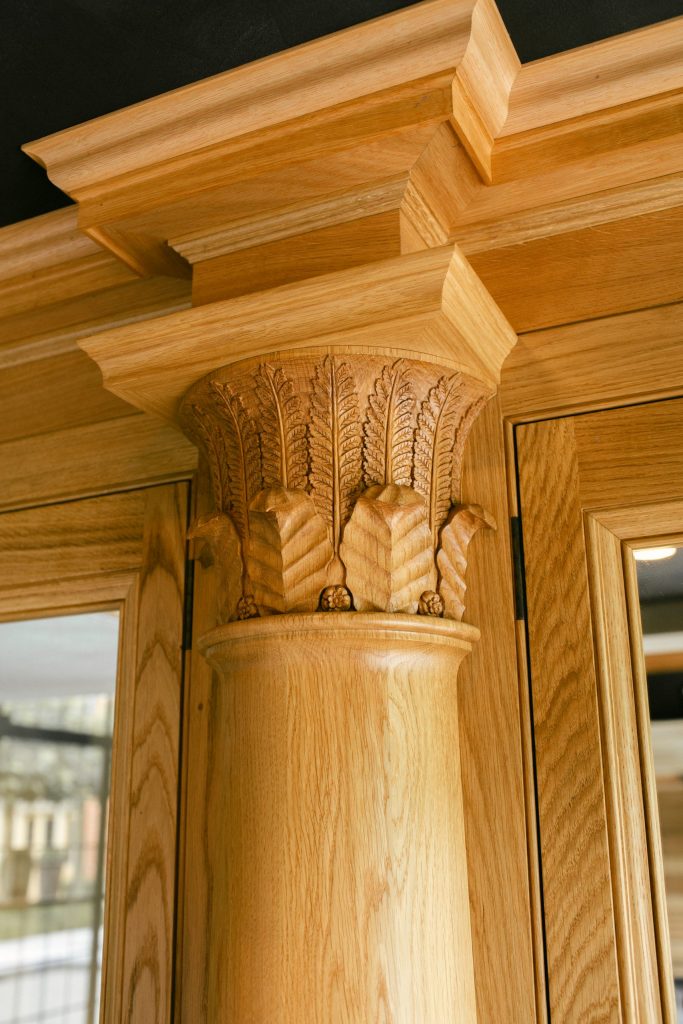
Decorative column capital on the Oak cabinets
The Sauna and steam room occupy the rear two bays created by the columns, with the front bays on the West side of the structure being used as circulation space and to house the two matching sets of cabinets that conceal the electronic equipment. I designed these cupboards to reflect the architecture in the main house, with unfluted Corinthian columns developed in our own style using the beech and fern leaf motif we had developed in the main hall of the house, to the centre of each of the cabinets. Either side are mirrored doors concealing pipework behind and allowing for storage of apparel, whilst beneath two decorative metal panels, designed by Lydia, are concealed dehumidifiers built into the plinth of the cabinets. Both cabinets were beautifully made and installed by Houghtons of York.
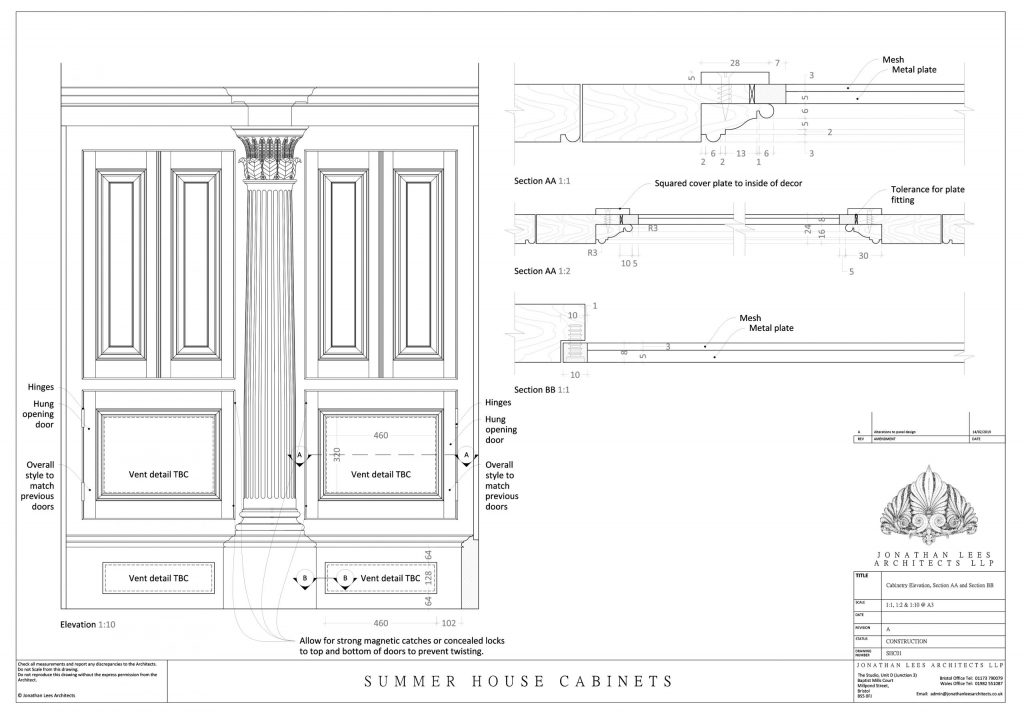
Detailed drawings of the summerhouse Oak Cabinets
For more photographs and details on the Oak cabinets and decorative panels see the Curiosities Emporium post about them here.
‘I had ideas of a stone monolith, something that resembled a single piece of stone from floor to ceiling…..‘
My initial thoughts on creating a central fireplace were that it should be simple and striking in scale. I had ideas of a stone monolith, something that resembled a single piece of stone from floor to ceiling, so we developed the design for a fireplace opening with a segmental arch and keystone over and allowing the stonework to continue with a taper to the intersection of the roof. We also allowed the oak rafters to pass and pocket into the stone, giving the appearance that the fireplace and chimneystack are a structural part of the roof.
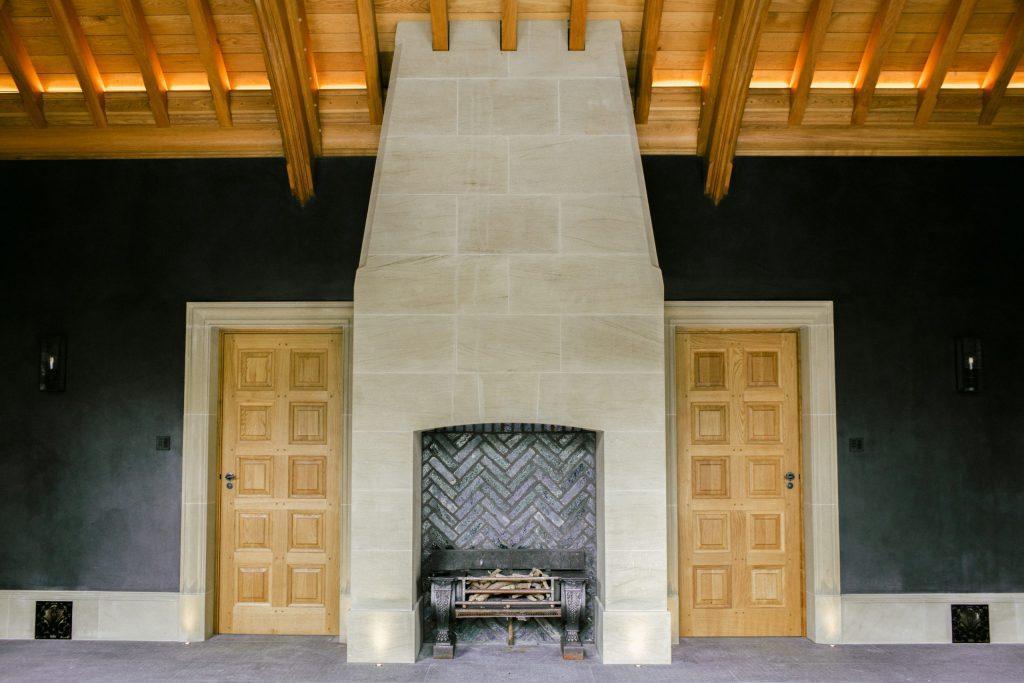
The feature stone fireplace with handmade black brick hearth
As within the main house, the back of the hearth was constructed using purple handmade glazed bricks set in black mortar, laid in a herringbone pattern. We were lucky enough to work with a supplier in London, who provided a sarcophagus grate, a 19th Century refurbished item, adapted for use with gas. The vision was to enable a roaring fire to be lit whilst enjoying the sunken spa pool at the centre of the room. Either side of the fireplace are two oak doors with stone architrave surrounds, sitting over stone skirtings. These lead to ‘Jack and Jill’ changing rooms, which form the East wing of the stable extension on the back of the Summerhouse.
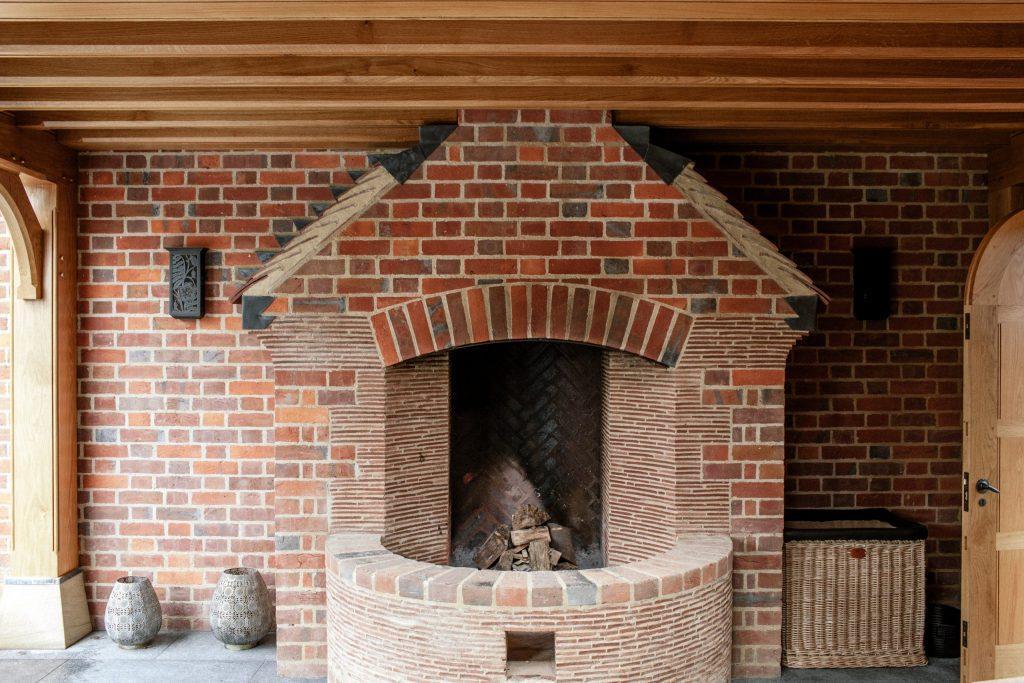
Outdoor brick and tile fireplace under a covered loggia
‘The whole construction of the fireplace took many weeks for the brick worker to lay…’
Either side of the Summerhouse, we originally developed a design for two open loggias formed in brickwork with oak rafters, however it soon became apparent the client wanted a covered space to enjoy in the winter and when it was raining, so Jess and I set about creating an open external fireplace on the South elevation of the East wing, that would readily link to the chimneystack we had created at the end of this structure, to serve the orangery fireplace. The external fireplace itself involved a lot of design work. I wanted to do something that was more Arts & Crafts involving less stonework, so I created a tall opening flanked either side in brickwork, with a segmental arch formed by a triple headed segmental arch with kneelers made in creasing tiles either side. Short sections of roofing tile create an angle that leadsto the central chimneystack, which punches through the loggia roof. The back of the fireplace was constructed using the purple coke-stained brickwork, as with the other fireplaces but the side cheeks were formed entirely of creasing tiles, including a deep 45 degree chamfer that was a testament to the front entrance of the main house. This then knitted together the semi-circular hearth that was created entirely using creasing tiles and brickwork. The whole construction took many weeks for the brick worker to lay and is a testament to the skill and patience that it requires to build such a thing. The hearth is also created using the purple handmade bricks and has a small chute at its centre to allow for debris to be cleared out.
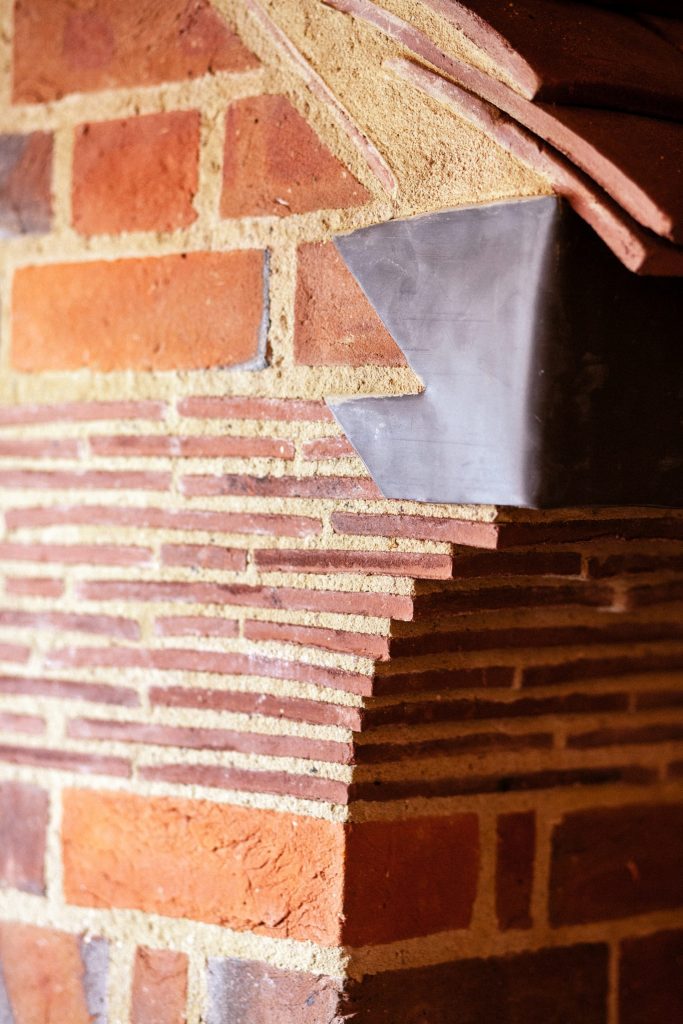
Detail of the outdoor brick fireplace
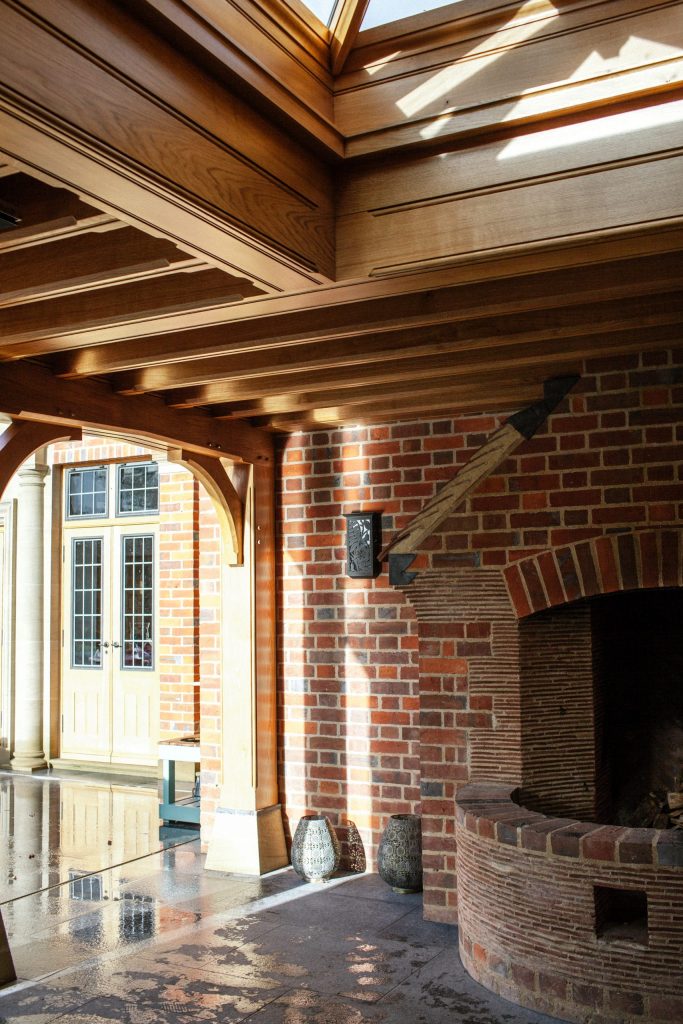
Garden loggia with rooflight and outdoor fireplace
For more photographs and details on the outdoor fireplace see the Curiosities Emporium post about it here.
The fireplace provides warmth to the covered loggia which is sandwiched between the North elevation of the Summerhouse and the South elevation of the main house. The loggia itself was designed by Scott and I, using a simple post and beam oak structure with bladed ties. The rafters are also oak with chamfered edges and long cyma mouldings to their end that project past the line of the beams, creating an overhang that matches that of the main house. A parapet wall created in leadwork conceals a hidden box gutter behind, with hidden downpipes in the posts to ensure that the oak upright members of the loggia are kept free. Each of the oak posts rest on a stone stylobate that has a small lead capping with the same tooled margin and scabbled field as the surrounding masonry used on the house and Summerhouse. The open loggia to the other side of the Summerhouse is constructed in the same way, but has no roof and is framed to the East, with a tall wall and lead capping detail that travels around the Southern flank. This terminates in a long, curved sweep that forms the Southern edge to the loggia, which in turn links to the central causeway where our brick loggias are positioned in the centre of the gardens.
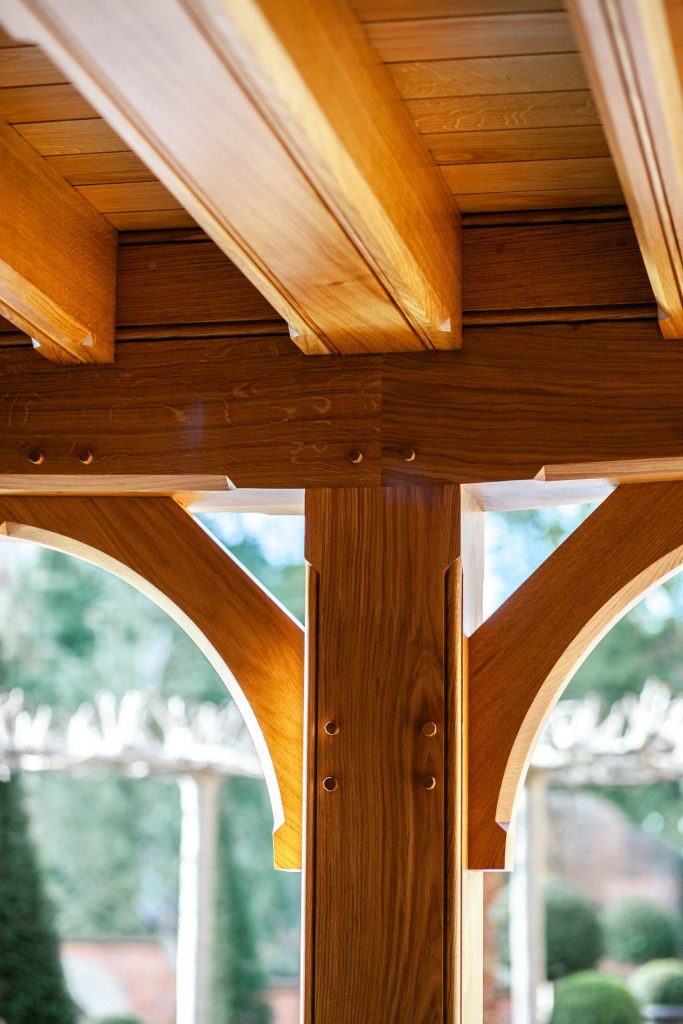
Traditional Oak details on the garden loggia
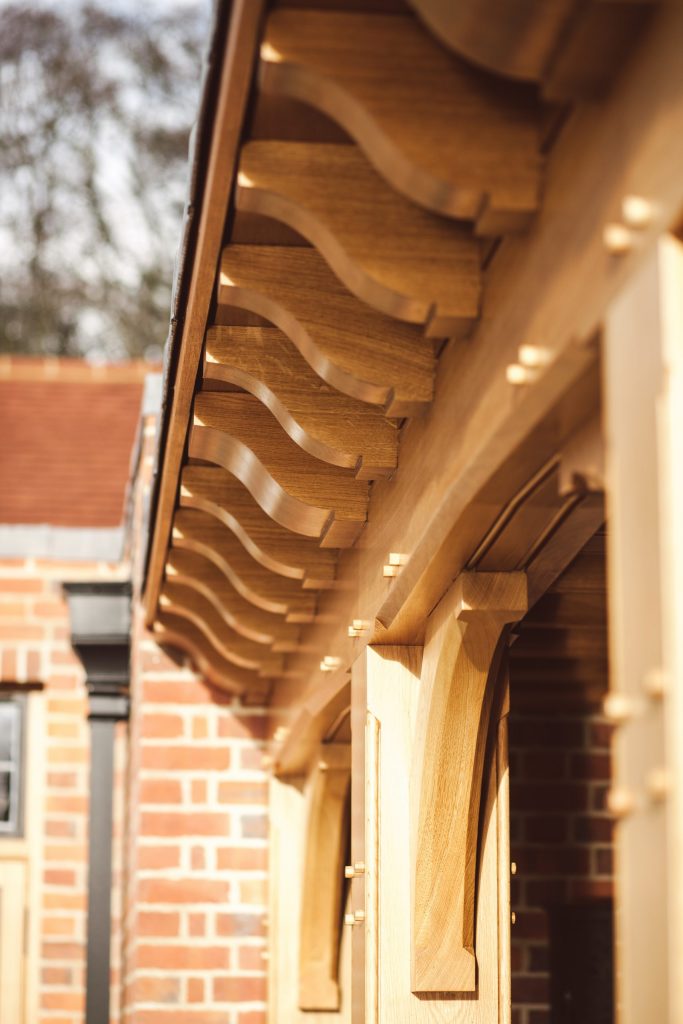
Rhythmic moulded rafter ends on the Oak loggia
‘The building is humanist in scale with all the details very much on show…..‘
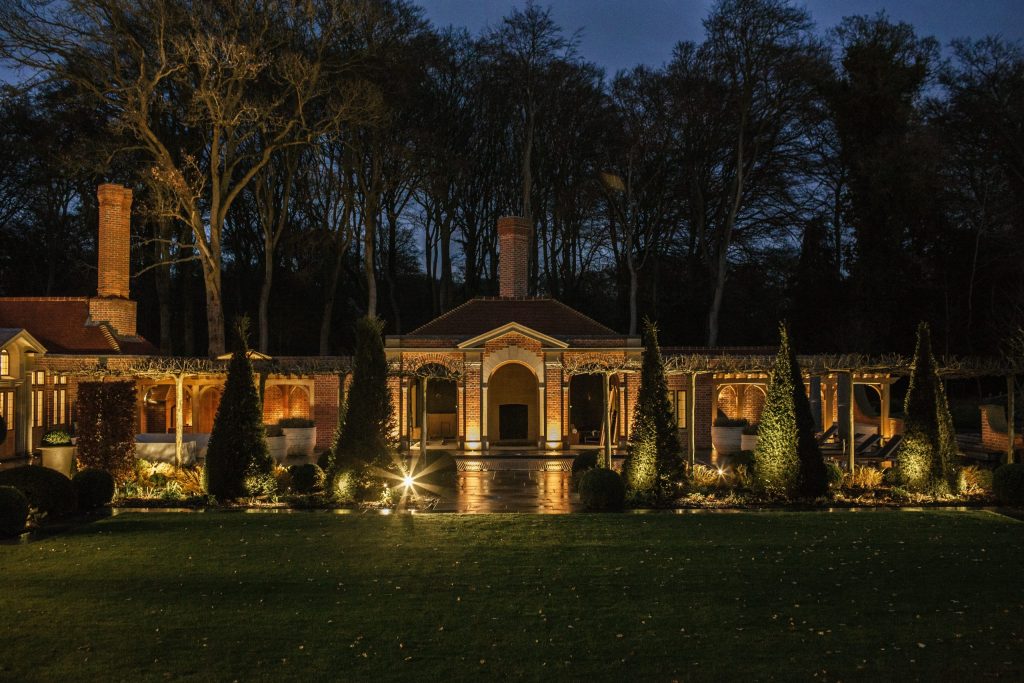
Pool house and loggias at night
The Summerhouse was designed to not compete with the architecture or scale of the main house, but to create a structure that would be inside-out, that would both celebrate the landscaping and the designs that we were carrying out to the gardens, as well as to complement and enhance the architecture of the main house, particularly the South elevation. The building is humanist in scale with all the details very much on show and able to be directly viewed from the ground. This meant that every cut, every brick joint and every detail had to be precise in order for the ensemble to work. The simple structure also includes a number of concealed details that enable the mechanical and electrical systems within the building to work, including ventilation systems, concealed speaker systems and concealed lighting that illuminates the structure and its features both inside and out.
Return to the Writings Library for more essays and Project Profiles
